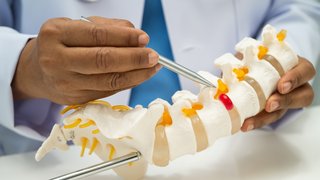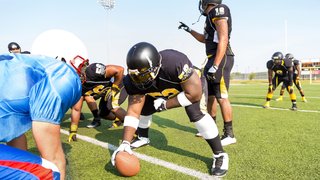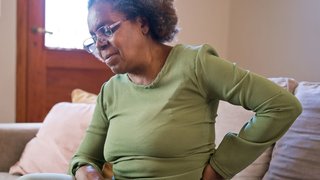What is an AC joint injury, and why is it so common in contact sports?
October 24, 2023

As soon as Indianapolis Colts quarterback Anthony Richardson hit the ground, the grimace on his face said it all: something was wrong with his right shoulder. The rookie QB was tackled on a running play against the Tennessee Titans on Oct. 8, 2023, and his throwing shoulder collided with the turf causing what is commonly referred to as an AC (acromioclavicular) joint injury, or separated shoulder.
A few weeks later, University of Texas Longhorns QB Quinn Ewers took a direct hit to his throwing shoulder on a running play and had to leave the team’s game against Houston.
Ewers is expected to miss a few weeks. Richardson underwent season-ending surgery.
Their injuries illustrate the wide range, or grades, of shoulder separations that are possible, the varying degrees of pain that accompany them, and the different treatment options available.
Separated shoulders are most common in contact sports such as hockey, rugby, or football, which often involve high-velocity collisions and falls. Cyclists may suffer an AC joint sprain after taking a spill off their bike. A 2023 study showed that about 44% of AC joint injuries were associated with sports. Separated shoulders are also a risk for contractors, who sometimes fall from ladders or scaffolding, and older people who fall at home.
The AC joint is located where the shoulder blade meets the collarbone – a vulnerable spot in a hard hit or a fall. It isn’t a bone injury, however. It’s actually a strain, tear, or rupture of the AC ligaments and/or coracoclavicular (CC) ligaments, which connect the shoulder bones to the collarbone.
While AC joint injuries are painful and require time to heal, they are highly treatable. In fact, UT Southwestern’s Sports Medicine and Shoulder team treats a high volume of complex cases, and I’ve never heard of a shoulder separation ending an athlete’s career.
Without treatment, you run the risk of living with chronic shoulder pain and instability. But with proper care from a shoulder or sports medicine specialist, most patients regain full function without restriction and usually without surgery.
How do I know if I have an AC joint injury?
It might sound cliché, but you’ll know something is wrong. Symptoms of a sports shoulder injury include sharp pain and swelling on the top of the shoulder with a visible bump, bruising, and tenderness, and limited shoulder mobility. While you’ll likely still be able to move your arm, reaching overhead is going to be painful.
If you fall or take a hard hit, see a doctor – ideally a shoulder or sports medicine specialist – for a physical exam, range-of-motion testing, and X-rays to rule out fracture. The specialist will help you plan next steps based on the type of AC joint injury you have:
- Grade 1: Sprained or partially torn AC ligament.
- Grade 2: Torn AC ligament and sprained or partially torn CC ligament – the type Ewers has, per ESPN.
- Grade 3: Torn AC and CC ligaments – what Richardson has, according to reports from the Associated Press.
- Grade 4: Torn AC and CC ligaments with a slightly dislocated collarbone.
- Grade 5: Both ligaments are torn, the clavicle is dislocated and shoved upward, and the deltotrapezial fascia, which supports the AC joint, is detached.
- Grade 6: The same as Grade 5 except the clavicle is shoved downward.
Will I need shoulder surgery?
Choosing surgery is a decision you should make based on your lifestyle and pain tolerance. Most patients recover all or most of their function with nonoperative treatment, such as:
- Rest: No reaching across the chest or overhead, lifting, leaning on the elbow, or sleeping directly on the shoulder.
- Ice: Apply an ice pack for 15 minutes every four to six hours as needed. Place cloth between your skin and the pack to avoid freezer burn on the skin.
- Pain-relieving medication: Acetaminophen, aspirin, or ibuprofen can dull the pain and reduce inflammation. Talk with a doctor about how much is safe for you to take, especially if you have other health conditions.
- Stabilization: You may need to wear a sling to offload the shoulder while the tissues heal.

For Grades 1-2, conservative treatment usually controls the pain. Athletes may get steroid injections in the joint to reduce inflammation and get them through the season, and some football players add an extra layer of cushioning under their shoulder pads to absorb impact and reduce further damage.
Grade 3 injuries are a gray area, depending on pain level, range of motion, and ability to reach overhead. Patients who work with their arms overhead – such as mechanics, contractors, and professional athletes – may benefit from surgery if the pain is intolerable at work.
Grades 4-6 usually need AC joint reconstruction surgery because severely torn shoulder ligaments don’t heal sufficiently on their own. You may also have more significant tissue and nerve damage from the dislocated collarbone.
How is AC joint surgery performed?
The goals of AC joint reconstruction surgery are to return the joint and collarbone to their proper positions and stabilize the shoulder by reconstructing the ligaments. Surgery can be a traditional open or minimally invasive procedure depending on the surgeon’s expertise and nature of the injury.
AC joint reconstruction involves making an incision in the shoulder and rebuilding or reinforcing the damaged ligaments with cadaver tissue or an autologous graft – tissue moved from another part of your body, such as the hamstring. In some cases, the surgeon will add sutures to hold everything in place as you heal. Most patients stay just one night in the hospital for pain management and monitoring.
There’s no specific timeline after the injury that you must get this procedure, though we often see patients who have dealt with pain for a long time or develop chronic stiffness or joint instability after getting insufficient treatment elsewhere. If you need surgery, choose a surgeon who is fellowship trained in shoulder procedures or sports medicine. They will be more familiar with options to treat your type of injury and more comfortable performing shoulder surgery, with a better chance that you will be satisfied with the results.
How long does recovery take?
Rehabilitation and full tissue healing typically take about three months following surgery, which can be frustrating for athletes and people who want to get back to work. Gravity will not be your friend for the first six to 12 weeks after surgery – if the weight of the arm pulls against the reconstruction, it will stretch everything out again. You’ll need to stabilize the arm in a sling and avoid overhead movements during this time.
As the tissues heal, our Physical Medicine & Rehabilitation specialists will guide you through personalized exercises to regain shoulder strength, improve range of motion, and prevent frozen shoulder, which is when the lining of the shoulder becomes inflamed, stiff, and incredibly painful. Most patients can return to full activities about three months after surgery.
We’ll ask you to attend annual follow-up visits for at least two years to ensure that your shoulder is healthy and strong. We’ll gather insights at these visits about how you feel, your range of motion, and your ability to return to activities. That information becomes part of an anonymized database that we use to continually improve your recovery and inform more precise care plans for future patients.
While painful and frustrating, a properly treated AC joint injury is not career-threatening for top-tier athletes like Richardson and Ewers, who should be able to return to full-strength throwing after appropriate rehab.
If you take a hard hit or fall, don’t wait to see a specialist – AC joint injuries are highly treatable and the sooner you get treatment, the faster you can get back in action.
To talk with a UT Southwestern sports medicine or shoulder specialist, call 214-645-8300 or request an appointment online.











